When I lived in Boston (actually Milford, MA), I remember an incident. I was sitting at a red light on the East side of town, and watched this little old man (90+ years) go to his office. He looked like he was on “deaths door”; just a short shabbily dressed old man. He hobbled down the sidewalk to this old store front.
The storefront was dusty. Inside the windows were pile and piles of papers, and the windows looked like they haven’t been scrubbed for decades. He produced a key and went in. Then closed the door behind him, turning the “We’re open!” sign on the old fashioned door.
I remember thinking about this older gentleman. Still running his business (whatever it was) in and out through the years. Insurance? Records? Dry cleaning? Attorney? Who knows. But he continued. It was part of his life.
Perhaps it was his responsibilities, and habits that helped him live into his grand old ages. Perhaps it is the idea of a “retirement” that is actually the death-blow to everyone.
We must provide purpose.
We must maintain responsibilities.
We must provide value to continue…
Bizarre Discoveries Found In Unexpected Places
Can US wage a war with China without suffering huge casualties and huge damage in bases like Guam etc and bases circling China and in carriers, fighter planes, subs, destroyers and space assets which are of utmost important to US in every way?
No they cannot. And the US generals know this and that is why they continually advise the politicians against war with China.
When the Pelosi visit happened, the USA pulled back its two carrier groups further away from Chinese Taiwan coastal waters. Now you know they always travel in protective formation for the sake of the carriers. When the Chinese conducted military drills including live missile firing off Taiwan in protest they landed enough missiles on every single position that the carrier group had been in 8 hours previously To the meter. Every single US ship in that group would have been sunk if that had been a real opening of the war. All of the US fleets in those waters would be lost in a real war. The chances of USA not using nukes as retaliation for this is near zero. That means 5 minutes after US nuke launch the Chines missiles would launch and China would take massive casualties. USA would lose Hawaii Guam Wake All the Japanese bases and most of American mainland cities. (There are only 30 US cities with more than 1 million people, so 30 nukes and they are gone) and most of the 100 US bases on home soil.
I suspect North Korea would take out the South Korean bases and cities and maybe even some Japanese along with Alaska. Im pretty sure China cannot or would not touch the US bases in Europe but they can reach all cities in USA with maybe the exception of Florida. . I guess maybe 100–300 million deaths in China and much the same in USA with the loss of all above ground bases on the mainland and in the Pacific. The generals all know this. The politicians dont, or dont care.
I wonder if Russia would take the opportunity to join in and get rid of their biggest warmongering problem altogether. 7000 nukes can make a mess of NATO and mainland USA if they did.
Carolina Hot Dog Chili

Ingredients
- 1 1/4 pounds ground beef
- 1 large onion (about 1 cup chopped)
- 1 (6 ounce) can tomato paste
- 1/2 cup ketchup
- 1 tablespoon chili powder
- 2 teaspoons Worcestershire sauce
- 1 teaspoon cider or white vinegar
- 1 teaspoon salt
- 1/4 teaspoon black pepper (optional)
Instructions
- Place the beef, onion and 2 cups of water in a Dutch oven or soup pot over high heat. Bring to the water to a boil. Reduce heat to medium and stir to begin breaking up the meat.
- Add the tomato paste, ketchup, chili powder, Worcestershire sauce, vinegar, salt and pepper, if using. Stir well until the tomato paste and ketchup are dissolved and the meat is mostly broken up.
- Continue to cook at a simmer, stirring about every 5 minutes, about 15 minutes. As the chili thickens, you may need to reduce the heat to medium-low or low so it doesn’t stick. Refrigerate, covered, up to 2 days, or freeze in small freezer bags for up to 6 months.
- Thaw or reheat in a microwave, stirring often.
If you want a finer texture, you can cool the chili at least 20 minutes and process in a blender or food processor for 30 to 45 seconds.
Approximate nutritional values per 2-tablespoon serving: 55 calories; 3 grams protein; 3 grams carbohydrate; 4 grams fat (58% calories from fat); 12 milligrams cholesterol; 0 fiber; 174 milligrams sodium
IMPOSSIBLE Places People Were Found
Hongkong media SCMP has tracked the number of US warplanes/warships at China’s door-step.
1,200 times in 2022 ! If this is not deliberate provocation & fight-picking by USA, what is it? Who is aggressive?
The key word here is : DOOR-STEP
Door-step in this article means outside your property line. Not inside.
Let say I walk at your door-step. On the street which is a public area. I have not entered your property line.
I carry something that looks like a rifle to you. Bullet-proof vest & helmet.
I have a track record that I made trouble for other households in the society.
How will you react to my appearance at your door-step if it is daily?
Now …
Let’s replace “I” with “USA”. “my rifle” with “US warplanes/warships”. “me at your door-step” with “USA at the door-step of China”.
Remember I am outside your property line. Same for US warplanes/warships outside China’s borderline according to UNCLOS.
Also, now replace “my daily” with “USA’s 1,200 times”
How will you react to my appearance at your door-step, daily?
If this is not DELIBERATE provocation & picking fights, what is it?
- Minding one’s own business?
- Assisting in keeping the region free of pirates?
- Being there to help ships in distress during storms?
There is police/law to stop my malicious action towards you. If there is not, will you do everything to protect your family?
There is ICC & UN laws eg Non-Innocent Passage as I said in other articles. But ICC is believed to be “controlled” by USA. USA was not charged for war crime in the 2003 Iraq war.
Hence China must protect itself.
Now USA scolds CHINA BEING AGGRESSIVE ???
Only a bully or mafia is that unreasonable.
OK, so now replace “my freedom to walk on public street” with “US freedom of navigation”
Only a bully or mafia will turn the logic upside down & conveniently use Freedom as god.
It is this type of twisted logic that USA justified their action to instigate riots/coups/wars in the world 82 out of 100 times, since WW2. Causing millions of deaths & human suffering.
We must ask :
- Why USA instigated riots/wars in Middle East for the past 20 years. OIL.
- What about China? Rise of China that, in US words, threatens US status on world stage.
China works hard to better itself & thus achieves a lots. IMF said China contributes 30% of world GDP.
Am I not allowed to get A+ in my exam just because you get F- in yours?
Only sore losers have the type of mentality to contain others.
Search Quora for a question:
What is Innocent Passage under UNCLOS ?
Woman Dies During Stroke; Shown Past Lives & Life’s Purpose During NDE
“If you ignore the lessons, they’ll keep throwing them at you.”
No Collapse Is the Real Dystopia
So far the 2020s seem more chaotic than previous decades. Based upon current events, economic and sociological data, and looking at historical cycles like the 4th turning theory and Peter Turchin’s research, it looks like there will be a major historical crisis this decade.
In contrast, the 2010s felt very stagnant, despite the recession at the beginning of the decade, and political movements such as Occupy Wall Street, nationalism and populism in Europe, the Donald Trump and Bernie Sanders movements, and the beginning of the Great Awokening.
Looking specifically at years, 2016 was a turning point with the election of Trump, 2017 was somewhat chaotic with political strife between antifa and the alt-right, then both 2018 and 2019 felt very stagnant.
Obviously 2020 was a chaotic year with the pandemic, as well as the BLM riots and acceleration in woke politics and cancel culture, with certain moments feeling apocalyptic. However, with the exception of Jan6th, 2021 was another stagnant year, with covid easing and the peak of the stimulus bubble and market euphoria.
Also in 2021, the right was totally demoralized and cancel culture had become the new normal. There was some return to chaos in 2022, with the onset of inflation and the Ukraine war. While this year has seen a banking crisis, dept default scare, migrant crisis, more political turmoil such as the inditement of Trump, and increased political instability overseas, overall things feel stagnant again, or perhaps a calm before the storm.
The perma bulls just won’t give up
It initially seemed that the Silicon Valley Bank crash would put an end to copes about economic recovery.
Despite recent fear of a debt default, major vulnerabilities in the financial system, higher interest rates, unprecedented levels of debt, sticky inflation, and the worst yield curve inversion in over 30 years, there is still a lot of bullish propaganda.
For instance talk of a mild recession, soft landing, a new bull market, and that we may have even dodged a recession altogether.
The bulls’ basis for optimism is a combination of the debt ceiling deal, official unemployment stats still being low, a slight dip in inflation, and hope for a pause in Fed rate hikes.
Not to mention the new cope of an AI boom saving the economy and ushering in a new bull market, which is just creating another bubble in stocks, on top of the existing super bubble.
This propaganda is in line with Janet Yellen’s infamous statement that we will never have another financial crisis again in our lifetime, the arrogance that the system is perfected to withstand collapse.
The cringiest bull take so far, is that the economy is doing great because of the exorbitant prices for Taylor Swift concert tickets, as obviously there are many affluent girls who use Daddy’s credit card to buy tickets.
If anything this just further shows the scope of the debt bubble, and high levels of income inequality.
The current vibes remind me a lot of January’s bullishness before the banking crash, though we will probably see some repeat of cycles of coming close to the imminent crash, followed by more copes of a recovery, before the inevitable big crash.

While bears have been vindicated, looking at the overall trajectory of the economy, there have been times over the past few years, when bears appeared wrong or overshot their predictions about the severity of an impending crisis.
For starters, expecting that covid would cause a depression, which did not anticipate stimulus propping up the economy, at least for the time being.
There was also concern, including from the mainstream media, that the Ukraine war was going to cause a global famine, the worst in modern history, by last fall.
However, there was a successful deal, negotiated by Turkey between Russia and Ukraine, to allow the safe shipments of Ukrainian grain through the Black Sea.
The question is whether a prolonged conflict, delaying Ukraine’s planting season, will mean a global famine within the next few years.
There were also expectations that Europe would have a catastrophic energy crisis last winter, which also did not pan out.
Even Russia limiting oil production did not spike oil prices as high as anticipated. Europe lucked out by having a mild winter, and enough petrol and natural gas saved up in their reserves, and extra help from America, as Biden depleted America’s strategic petrol reserves.
Overall it was a combination of certain supply chain issues getting resolved from the pandemic and war, but also a decline in global demand, and just kicking the can down the road.
In order to have a healthier economy, it is necessary for super bubbles to pop, and a similar case can be made for social and political ills.
Since the pandemic mostly exacerbated the worst trends of the 2010s, such as social atomization, the mental health crisis, the sex recession, income inequality, the establishment consolidating power, cancel culture, cultural decay, and overall cringe, the question is whether a severe economic collapse would clear out societal bullshit or just make these problems worse.
An economic soft landing or stagnation scenario would likely exacerbate the worst existing trends, so I totally get the doomers and accelerationists who cheer on the collapse.
However, dissidents, who are often in despair, or feel that the current system is stacked against them, have this fantasy cope, that when the big collapse occurs, either they or their ingroup will do better or be liberated from systems of oppression, which is incredibly naïve. Dissidents have no institutional power and this doomer mentality is very passive, primarily fulfilling a psychological need. If one’s life and inner psyche is in chaos, one tends to want to see the cold indifferent society around them collapse as well.
Doomers rely upon this fantasy that one external shock to the system, or Black Swan event, will cause the entire system to come crashing down like a house of cards, but the system has shown itself to be much more resilient than that.
California shows that a one party liberal hegemonic system can last much longer than one would think, though it has been sustained by Silicon Valley revenue, and the exodus of the middle class acting as a safety valve for discontent. The financial propagandists who talk of a soft landing are partially correct, in that it is a soft landing or no recession for those at the top.
In fact, America is working great for the people who run it, but not for those with no power and influence.
The incoming severe recession may just mean more urban blight, homeless encampments, increased deaths of despair, and widening income inequality, but not necessarily a collapse of institutional power.
Anonymous 4chan post from 2013
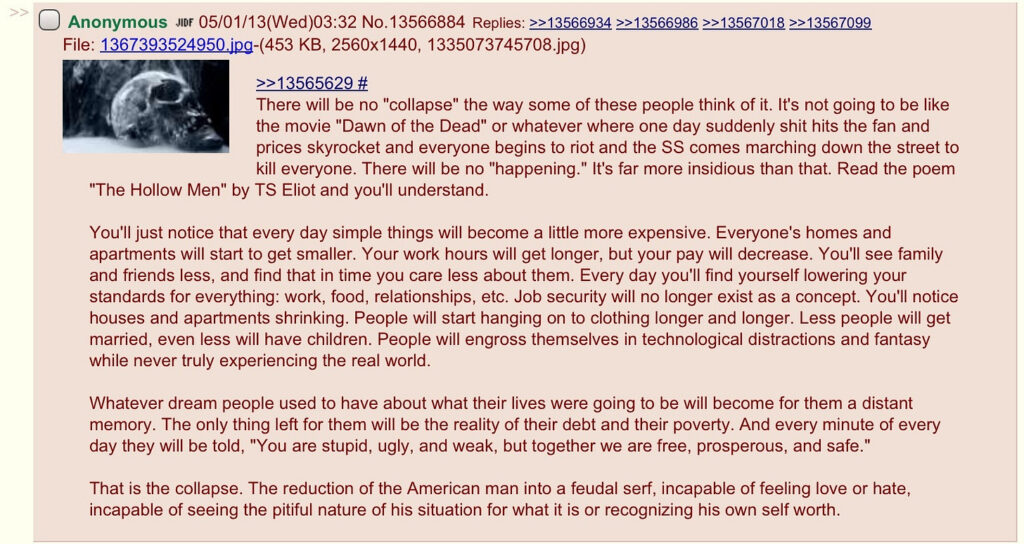
The prophet of despair, Michel Houellebecq, has been totally vindicated in his prediction from the beginning of the pandemic that post pandemic life would be “the same but worse.”
Collapses are often gradual and not overnight, and not necessarily a Mad Max scenario, but rather collapse just means a lower quality of life for most people. This is even true for third world nations that have collapsed, like Sri Lanka, or with the current high levels of inflation in Turkey and Argentina.
“The nightmare is not the “collapse.” The nightmare is that they pull off the End of History, and things just gradually get worse – more crime, more poverty, more degeneracy, fewer services, and a population incapable of anything other than demanding larger doses of the poison,” tweets VDARE’s James Kirkpatrick.
Basically a gradual decline in people’s quality of life or a frog in the boiling pan scenario, where people just get used to degradation, and may never actually reach that breaking point but rather merely adjust their expectations and standards.
Dissidents rely upon this fantasy of the masses awakening and rebellion, but with lower wages and higher unemployment, there is just greater leverage to those in power and less to the people.
The political elite must factor in that some type of economic crash means that people will be desperate enough to work for little or nothing and give up their freedoms and autonomy.
The question is whether Americans, especially middle class Whites, can psychologically handle the decline and transition to a post-American order?
Federal Reserve Chart of change in Foreign Exchange Reserves
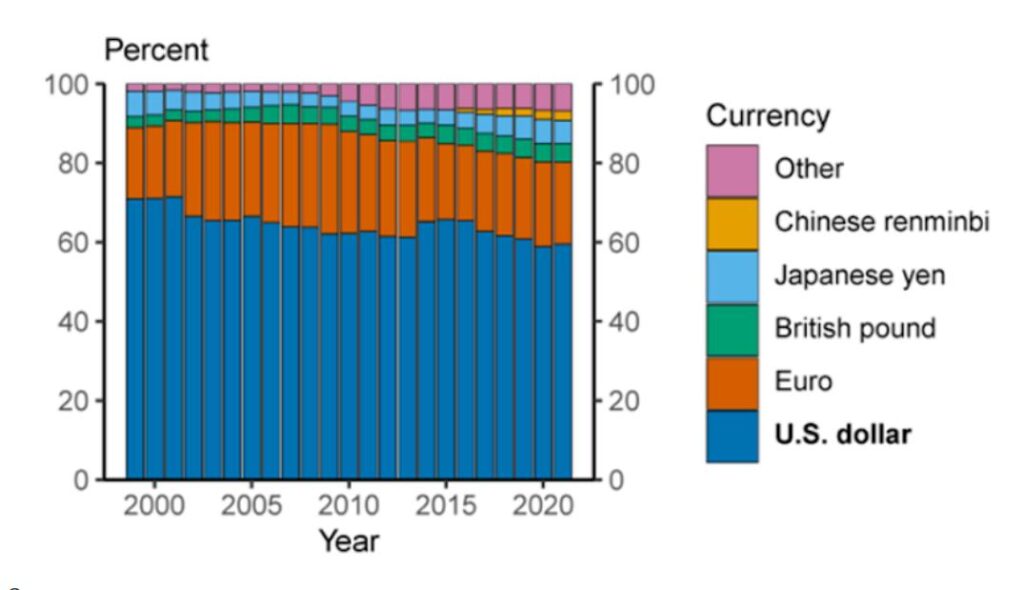
A probable scenario is where the US economy has a quasi-soft landing but at the expense of the rest of the world, by abusing the reserve currency to export inflation abroad.
For instance, nations being forced to play catch up with the Fed’s rate hikes in order to save their currencies.
This will accelerate the migrant crisis and increase resentment against America, with the potential for retaliation against the dollar.
America would go into a depression, if it lost its reserve currency status, but the dollar still dominates foreign exchange reserves, with no clear competitor.
On a similar note, an AI boom could turn the economy around after the recession, perhaps even a period of rapid economic expansion, but would also exacerbate income inequality and gradually erode the value of labor.
While there will likely not be a debt default anytime soon, the main danger now is the Treasury being forced to sell treasury bills and bonds, which would drain liquidity in the financial markets, thus exacerbating the banking crisis, push commercial real estate over the edge, and cause a pension solvency crisis.
Not to mention, exacerbating the financial trap that the Fed is in, where if the Fed pivots or bails out the banks, inflation resurges, but if rates are kept high, there will be a liquidity and debt default crisis.
Whether this will be the financial event that causes the big crash is hard to say.
Overall, the main vulnerability in the economy is the sheer levels of debt, both public and private, in which the response will likely be inflating the dollar to pay off massive debts.
The crash has taken much longer than anticipated, like watching paint dry, and I am done trying to guess when this mega crash will occur.
Generally I take the view that the economic bubble is just being propped up further, and that the inevitable is being delaying, which will lead to a much worse economic crisis.
However, what if this is all part of a successful managed decline, or manufactured stability, which is really depressing and demoralizing.
America is in decline but it is a stretch to say collapse, but rather a long term multidecade process, a slow motion decay, analogous to Rome’s decline as a late stage empire, which took a very long period of time to fall. America has both advantages over other nations and major vulnerabilities.
People are being killed over this – UFO whistleblowers EXPOSE the deep state agenda
US Attempts ’Divide and Conquer’ Strategy Against BRICS
JOHN TITOR: Time traveler, soldier, savior
Will China go bankrupt if it is no longer able to sell to the US market?
Nope.
People often think that China is extremely, extremely dependent on manufacturing goods and exporting to other countries.
Actually, China’s services sector is already bigger than its industrial sector. Furthermore, manufacturing is only one of three components in its industrial sector (the other two being construction and mining).
In addition, the biggest market for Chinese goods is actually China itself. Which also happens to be the biggest consumer market in the world.
Finally, it’s worth noting that while the USA is the biggest importer of Chinese goods, what the USA imports is only about the amount purchased by Hong Kong, Japan and Korea each year.
Meanwhile, there are still 120+ other countries that buy more goods from China, than any other country on earth.
To summarise, China doesn’t just manufacture & sell goods for a living. That isn’t even its main thing. Furthermore, while the USA is its biggest customer, the USA is still just one customer, out of MANY customers.
Egypt Shocking Announcement Joining BRICS: What It Means for the World Economics
https://youtu.be/w-92OEYxqMc
Amid U.S. “de-risking” rhetoric, world relies more on China’s exports — SCMP
Amid so-called “de-risking” rhetoric led by the United States, as the world relies more on China’s exports, China is learning to rely more on itself, reported the South China Morning Post. So far, Washington’s actions have little to show for results.
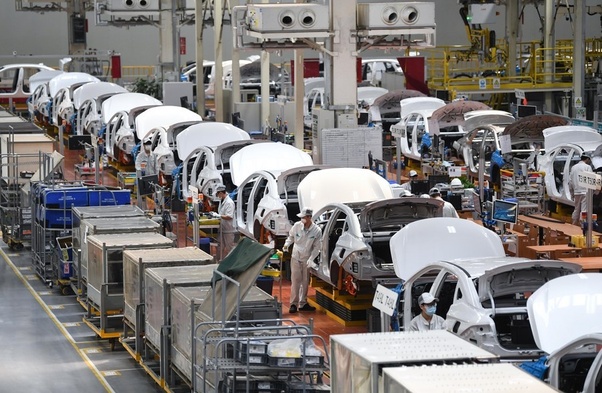
According to official U.S. data, the United States’ merchandise trade deficit with China was larger last year than when former President Donald Trump took office, and the overall trade deficit is at a record high.
Moreover, U.S. imports of manufactured goods have not moderated, with import penetration rising to 34 percent from 31 percent in 2017, the article said.
There has been a dramatic decline in China’s importance to U.S. trade, but China’s exports to the world have risen to record highs in recent years.
China has moved on from being largely an assembler of imported components to a manufacturer of sophisticated products, which has made China more self-sufficient.
12 ALIEN CRAFT In US Custody, Intel Confirms; One Source Claims PILOT Found: Michael Shellenberger
Why did Dell publicly announce their decision to move all their production out of China and stop using chips made in China by 2024, leading to a 45.1% fall in sales in that market, when they formerly were one of the top ranking brands in sales?
Ah!!!
Other way round
Dells announcement came after their market share fell in China
It’s simple
Dell doesn’t have a good market in China anymore
It’s sinking by the day
When I visited the previous time, i wentto the malls to see the laptops and saw a lot of Dell, IBM & HP Laptops dominating in every showroom and shop
This time I saw only Realme, Xiaomi, Redmi, Honor (Huawei) laptops selling like hot cakes with only Apple selling at the same demand
Nobody is buying Dell in China anymore
So Dell will move out of China because they lost the huge Chinese market
They have no chance in US except with high level IT infrastructure where IBM dominates the market or laptops where Apple is the king
Like Samsung
Dell will come to India and hope to make India a cornerstone market because Dell is our leading laptop and our Domestic laptops are a big disaster to date
Kenya Drops The U.S. Dollar
Should the US enter into a Cold War with China?
US still mired in a Cold War mindset, but tide is turning
At his long-awaited face-to-face G20 meeting with President Xi Jinping, US President Joe Biden reaffirmed that notwithstanding vigorous competition, mutual conflict must be avoided. He cited the need for cooperation in a range of transnational challenges, including climate change, debt relief, health security, and global food security.
According to Chinese press reports, Biden doubled down on earlier pledges of nonconfrontation to encompass “five no’s” and “four no-intents” — no seeking of regime change; no new Cold War; no ganging up against China; no support for “Taiwan independence”; no support for “two Chinas”; no intention of conflict with China; no intention to decouple from China; no intention to hinder China’s economic development; and no intention to contain China.
However, these nine specific pledges do NOT appear in the relevant Washington readout. Rhetoric and diplomatic niceties aside, anti-China hype, postures and measures are likely to persist, fueled by strong bipartisan consensus of a systemic “China threat” echoed by a “hegemonic coalition” of America’s closest Western allies.
I experienced this continuing anti-China blowback firsthand as a sponsored speaker during a recent international conference, From Crises to Crises: Towards a New World Order — MEDays 2022 — held in Tangier, Morocco, from Nov 2-5. My three American co-panelists, all senior foreign policy advisers across the aisle, seemed to sing from the same robust anti-China hymn book.
I commenced by saying that I didn’t see how constantly antagonizing a targeted adversary can be regarded as a strategy.
I pointed out that all decoupling, sanctions, tariffs, denial of key technology access, and corralling Western allies to suppress China do not seem to have yielded meaningful outcomes.
With Ukraine-war disruptions and a faltering global economy, they have backfired on the United States (and the rest of the world), necessitating unprecedented serial interest-rate hikes to curb rising inflation.
With the possible exception of some of America’s closest allies in the so-called Five Eyes alliance, many countries do not wish to be forced to take sides, as China has become the largest trading partner to 128 out of 190 nations across the globe.
China’s centrality to the global supply and value chain is particularly prominent in the world’s largest trading bloc (accounting for one-third of the global economy and one-third of the world’s population), the Regional Comprehensive Economic Partnership, which comprises the 10 member states of the Association of Southeast Asian Nations, as well as their principal trading partners — Japan, Australia, New Zealand, South Korea and Singapore.
I also pointed out that the Chinese government, under the leadership of the Communist Party of China, has been successfully winning the highest support and trust of the vast majority of the Chinese people, multiple rankings above many other Western democracies, including the US, according to the most recent comparative studies conducted by the Harvard Kennedy School Ash Center and the Edelman Trust Barometer.
Although I didn’t have the time to go into the details, the Edelman findings show that China is the biggest people’s trust winner in this year’s survey, thanks to the decisive action taken to prevent the spread of the COVID-19 pandemic within the nation and a rising pride in China’s global gravitas despite escalating US tensions.
I contrasted the legitimacy between China’s CPC-led system and Western adversarial democracies. The all-time CPC imperative is to bring about much better lives for people across the whole nation, while adversarial democracies tend to focus on vested interests and voters supporting the winning political party in every election cycle.
As for alleged “technology theft”, I mentioned the example of China’s success in building its own space station from scratch. China had also succeeded in landing a robotic probe at the back of the moon ahead of all other nations.
I said that despite substantial advancement, China has neither the intention nor the full military, financial and monetary capability to supplant the US as a world hegemon.
As is clear from the CPC’s 20th National Congress, what China is seeking is to realize the “China Dream” of national renaissance by 2049 — the 100th anniversary of the founding of the People’s Republic of China — to reestablish China’s historic place in the sun, so to speak.
I admitted there have been substantial US-China disagreements and concerns. But building a bridge with a multitrack dialogue would be more productive than constructing fences and barriers.
How China responds to what President Xi calls a world “crossroads” amid “momentous changes unseen in a century” is embedded in his speeches at the 17th G20 summit in Bali (Nov 15-16) and at the APEC CEO summit in Bangkok (Nov 17), as well as in Premier Li Keqiang’s speech at the 25th China-ASEAN summit in Phnom Penh (Nov 11).
Xi outlined a clear vision for an “Asia-Pacific community with a shared future”. The region is “no one’s backyard”, nor should it become “an arena for big power contest”. It should embrace “openness and inclusiveness”, guided by “diversity and nondiscrimination”, enabling “win-win cooperation” and “regional economic integration” free from any supply-chain disruption or dismantling.
Rejecting a “Cold War mentality” and “bloc confrontation”, Xi puts forth the idea of “common, comprehensive, cooperative and sustainable security” in a “Global Security Initiative” based on the United Nations Charter.
Specifically, Xi proposes building a “free trade area of the Asia-Pacific”, including reform of the World Trade Organization, better alignment among the RCEP, the Comprehensive and Progressive Agreement for Trans-Pacific Partnership, and the Digital Economy Partnership Agreement,
For the world at large, Xi stresses that “drawing ideological lines or promoting group politics and bloc confrontation will only divide the world, and hinder global development and human progress”. He espouses a Global Development Initiative, under which more than 60 countries have joined a GDI Group of Friends.
China has established the Global Development and South-South Cooperation Fund, and will increase its funding for the China-UN Peace and Development Fund, in furtherance of the 2030 UN Agenda for Sustainable Development.
Xi refers to China’s submission of 15 projects to the G20 Action for Strong and Inclusive Recovery, working with G20 members on delivery.
Opposing the politicization of food and energy issues, the president points to China’s joint Initiative of International Cooperation on Resilient and Stable Industrial and Supply Chains, the Global Clean Energy Cooperation Partnership, and the International Cooperation Initiative on Global Food Security in the G20.
It’s clear that under President Xi’s leadership, China is proactive in taking on a much larger role to help build a better world in a “community of common destiny”, bound together by global challenges like climate change, pandemics, food and water security, terrorism and development bottlenecks. This should be welcome.
The pivotal question is whether the US, as the world’s leading superpower, can rise beyond “American exceptionalism” and a zero-sum, “win-lose” mindset.
For decades, the CPC has been consistently misunderstood, misjudged and misrepresented, if not thoroughly demonized, by the West, including some of the most respected authors, broadsheets, think tanks, journals and other media outlets.
The so-called “China threat” is reaching a crescendo, portraying the US-China rivalry as a “life-or-death” contest between “democracy and autocracy”. This can be seen in tomes like The Hundred-Year Marathon: China’s Secret Strategy to Replace America as the Global Superpower (2015), The Return of Great Power Rivalry (2020), and Danger Zone: The Coming Conflict with China (2022). According to the Washington-based Pew Research Center, unfavorable views on China are reaching historic highs in many countries.
Rhetoric aside, Biden’s assurances at his three-hour-long meeting with Xi in Bali focused on guardrails rather than blue-sky thinking. The upcoming 2024 US presidential election and the election for Taiwan’s leader are also likely to politicize issues prone to upsetting the apple cart, though not necessarily resulting in war. I’m, therefore, not overoptimistic about a lasting breakthrough in US-China relations.
However, according to Organization for Economic Cooperation and Development calculations, developing countries will account for nearly 60 percent of the world’s GDP on a purchasing-power parity basis by 2030. More are becoming confident enough to exert their national interests, individually or collectively, in defiance of hegemonic strong-arm tactics. OPEC’s recent refusal to expand oil production on the US’ say-so is a case in point. More are likely to have China as the largest trading partner and to welcome a more-inclusive world order not drawn on ideological lines, as espoused by Xi.
As the pandemic recedes and as its economy resumes running on all cylinders, China is likely to be on track to become the world’s largest economy in nominal terms, perhaps by the early 2030s, and a strong, more-advanced socialist economy by 2035 as planned, thanks to rising productivity (despite worsening demographics) driven by robotics and a digitized economy, technological innovation, high-speed-rail-connected supercharged urbanization, and a rapidly expanded middle class of some 800 million by 2035.
If China could manage to bust the West’s allegations concerning trade, intellectual property and human rights “transgressions”, Xi’s panoply of concrete ideas, initiatives and proposals for a global community of common destiny are likely to gain faster traction and momentum, regaining for China its rightful place in the sun as the “China Dream” of national renaissance is eventually realized.
China Will Protect Taiwan “At ANY Costs”
https://youtu.be/9tzlT0VPwpE
On The Failure Of The Ukrainian Counterattack
On June 4/5 the Ukrainian military launched its long announced counteroffensive in southeast Ukraine. Ten days later there is no significant progress.
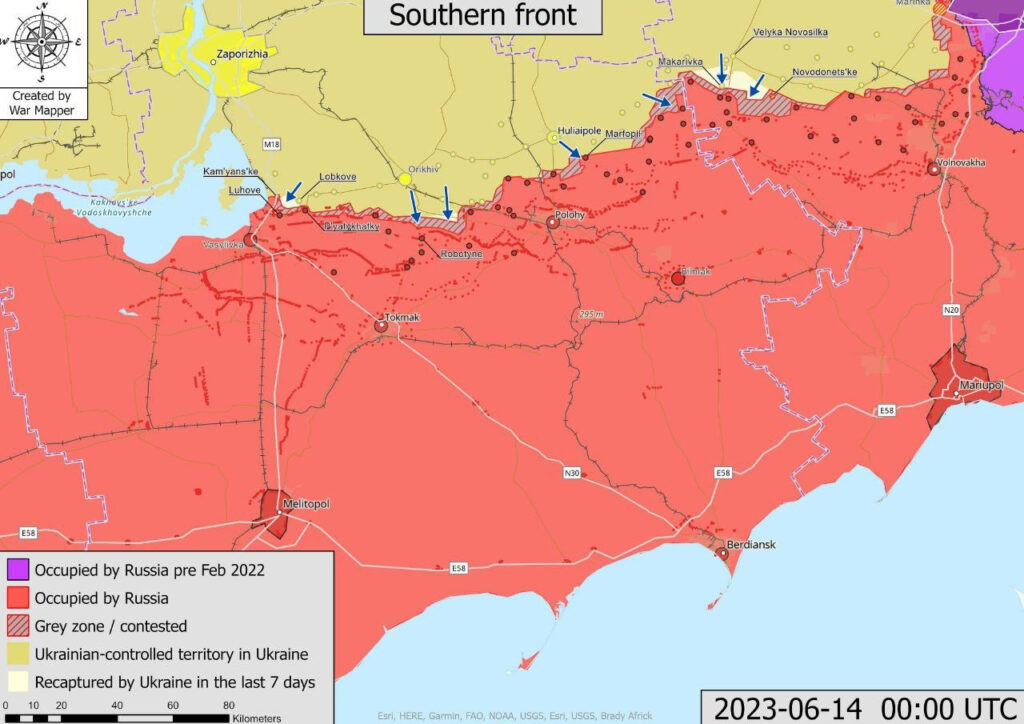
biggerThis is not the outcome the war propagandists expected:
[General Petreus] spoke about the situation in Ukraine to BBC Radio 4’s Today programme.On the counteroffensive, he said:I think that this counteroffensive is going to be very impressive.
My sense is that they will achieve combined arms effects in other words, they will successfully carry out combined arms operations where you have engineers that are breaching the obstacles and diffusing the minefields and so forth; armour following right on through protected by infantry against anti-tank missiles; air defence keeping the Russians aircraft off them; electronic warfare jamming their radio networks; logistics right up behind them; artillery and mortars right out in front of them.
And most important of all … is that as the lead elements inevitably culminate after 72-96 hours, physically that’s about as far as you can go, and they’ll have taken losses … you have follow-on units that will push right on through and capitalise on the progress and maintain the momentum and I think that can get the entire Russian defence in that area moving, then I think you have other opportunities that will open up on the flanks as well.
Back in reality the lead elements of the Ukrainian attack got slaughtered. They ‘culminated’, i.e. lost their ability for further attacks, in less than a day:
The men of Ukraine’s 37th Brigade were freshly trained and armed with Western-supplied weapons, tasked with an initial push through Russian-occupied territory in the early days of a long-awaited counteroffensive.They would pay a heavy price.
Within 20 minutes of their June 5 advance south of Velyka Novosilka, in the southeast Donetsk region, mortars exploded all around them, soldiers said. A 30-year-old soldier known as Lumberjack saw two of the men in his vehicle bleeding heavily; one lost an arm as he cried out for his family. Lumberjack crawled into a crater, but the shrapnel from a mortar went through the soil and pierced his shoulder.
“We were left there in the field, without tanks or heavy armor,” said Lumberjack, who spoke to The Washington Post on the condition that he be identified only by his call sign because he was not authorized to discuss the battle. “We were shelled with mortars from three sides. We couldn’t do anything.”
There were fewer than 50 men in the unit, he said, and 30 did not return — they were killed, wounded or captured by the enemy. Five of the unit’s armored vehicles were destroyed within the first hour.
Whoever trained those units made grave mistakes:
For the first hour and a half of the 37th’s assault near Velyka Novosilka, the Russians bombarded the unit with nonstop shelling that penetrated their AMX-10 RC armored vehicles, according to Grey, another soldier in the battalion who spoke on the condition that he be identified only by his call sign. The armored vehicles, sometimes called “light tanks,” were not heavy enough to protect the soldiers, Grey said, and had to be positioned behind them instead of in front.
The AMX-10 isn’t a tank and can not be used as one. It is a wheeled light reconnaissance vehicle built by France 50 years ago to dominate insurgents in its former African colonies. One of its main features is to have a good speed when in reverse gear. This to bail out as soon as serious counter forces are detected.
The Ukrainian counterattack is now stuck in the Russian defense security zone, miles away from the real defense lines. This was predictable.
As the U.S. Field Manual 100-2-1 described the Soviet army in defense (pg 93ff):
When the defense is established before contact with the enemy, the Soviets establish a security echelon up to 15 kilometers forward of the main defensive area. The elements which make up the security echelon come from the division’s second echelon. A security force of up to battalion size may be deployed in front of each first echelon regiment.A detailed and coordinated fire plan is developed. Weapons are positioned so that the maximum amount of fire can be brought to bear directly in front of the [Forward Edge of the Battle Area]. Enemy penetrations are blunted by shifting artillery fire and by conducting counterattacks.
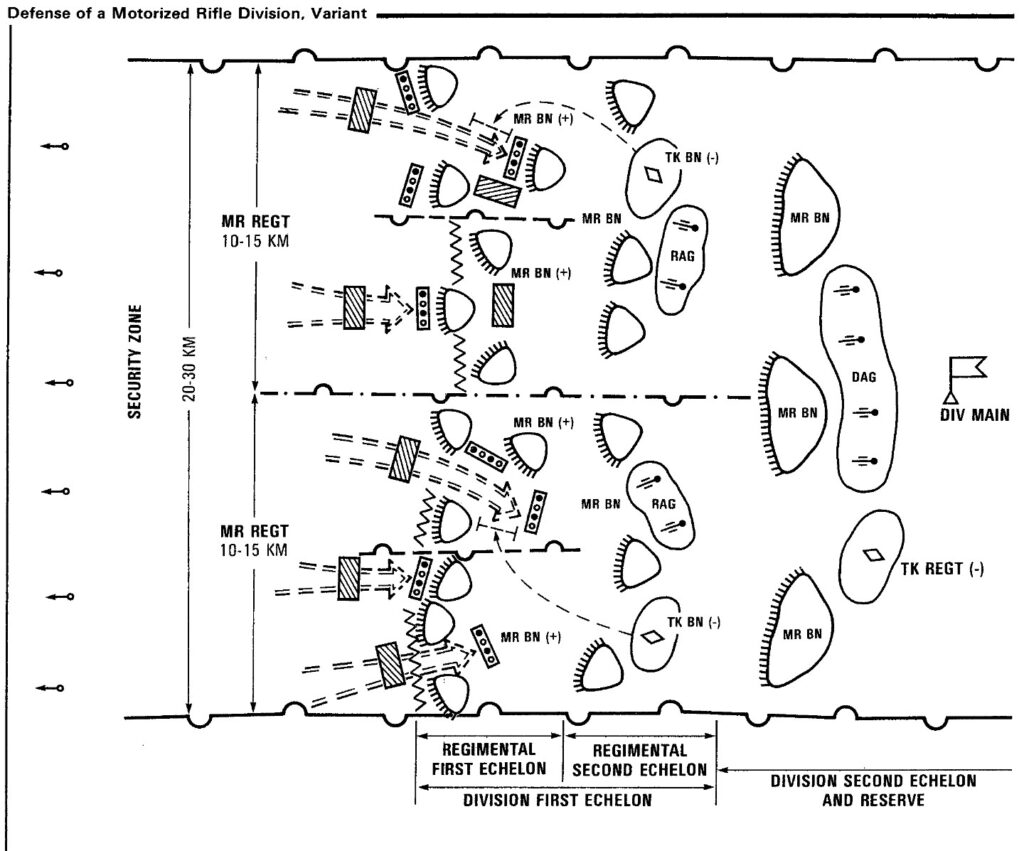
biggerThe Ukrainian army used at least four brigades for its attack. At least two of those were from the 12 brigade reserve that had been built up for the counterattack. With losses of some 30% those involved were seriously mauled for little to no gain:
The Russians are trying to inflict as many casualties and destroy as many vehicles as possible in a battle zone ahead of the main defensive line, depleting Ukrainian forces before they reach it. In effect, it turns the area in front of the main defense line into a kill zone.
…
If the Russian strategy proves effective, Ukraine could lose too many of its newly trained troops — which number in the tens of thousands — and too many tanks and infantry fighting vehicles to breach the main line.Even if they get that far, the forces might be too weakened to stream south and help accomplish a major objective: severing the so-called land bridge that connects Russia to the occupied Crimean Peninsula. This would be done by reaching the Sea of Azov, about 60 miles away.
The Ukrainian forces were obviously not trained for this. They also attacked in too many places. The map at the top shows attack arrows in 7 places and four main directions. One or two attack directions, with more concentrated forces, might have created better results.
The Russian President Putin recently described the Ukrainian casualties:
I will not give the number of personnel losses. I will let the Defence Ministry do it after it runs the numbers, but the structure of losses is unfavourable for them as well. What I mean to say is that of all personnel losses – and they are approaching a number that can be called catastrophic – the structure of these losses is unfavourable for them. Because as we know, losses can be sanitary or irretrievable. Usually, I am afraid I may be off a little, but irretrievable losses are around 25 percent, maximum 30 percent while their losses are almost 50/50. This is my first point.Second, if we look at irretrievable losses, clearly, the defending side suffers fewer losses, but this ratio of 1 to 10 is in our favour. Our losses are one-tenth of the losses of the Ukrainian forces.
Since the start of the counterattack the Russian daily report has listed a total of some 10,500 Ukrainian casualties.
A second large attempt to cross the Forward Edge of the Battle Area (FEBA) with the remaining Ukrainian forces is expected, but is unlikely to have a better outcome. The long promoted Ukrainian counterattack is likely to end with high Ukrainian losses and no gains.
This then will soon become a huge political problem:
As he heads into next year’s reelection campaign, Biden needs a major battlefield victory to show that his unqualified support for Ukraine has burnished U.S. global leadership, reinvigorated a strong foreign policy with bipartisan support and demonstrated the prudent use of American military strength abroad.
…
A muddled outcome of limited gains in Ukraine would provide grist for all of those critiques and further cloud the already murky waters of NATO and European Union debate over future posture toward both Ukraine and Russia. A less than “overwhelming” success would probably also increase pressure in the West to push Kyiv to negotiate a territorial settlement that may not be to its liking.
There is little the Biden administration can do to change the grim picture. Congress will likely prevent it from openly using the U.S. military in Ukraine. The European NATO allies have now seen what the Russian army can do to its enemies. They will not be eager to see the same done to their own troops.
That leaves negotiations as the only way out.
The question for Russia is when and with whom. Talks with only Ukraine, a mere U.S. proxy with no real say, would be insufficient. It is the U.S. government that must agree to a new security architecture in Europe. The Russian conditions for peace will be harsh and it will still take a lot of time, and many dead Ukrainians, until the U.S. agrees to them.
Posted by b on June 16, 2023 at 14:47 UTC | Permalink
Chinese says 24 hypersonic anti-ship missile will sink #USSGeraldRFord carrier fleet
What are some of the reasons why China would never start a full-scale military conflict with the United States, even though they have a military advantage over us?
There are many reasons.
[1] China is a peaceful nation. It considers war to be the absolute result of failure to resolve differences. And, China, being a merit driven nation, avoid failure at all costs.
[2] China has no need to fight the United States. There is nothing the United States has that China wants. This aspect of reality is at odds with the American narrative, but seriously trade with the United States is trivial, and what ever technologies that remain in the United States is not exclusive. China has “work-arounds”. The idea that “China would collapse without the United States” is a trope that feeds a proportion of the most ignorant of Americans.
[3] China is doing quite well right now. There is no need to change the status quo one way or the other. China is content to leave things stay as they are.
Of course, these reasons are pretty basic.
There is ONE REASON why China actually WOULD start a full-scale military conflict with the United States. This is the one and only reason. That is if China is attacked.
To avoid being attacked, China has clearly explained to the United States what an attack entails. That way there is no ambiguity. China might be many things, but when it need to be blunt, it spells out its position clearly.
For those who cannot read Chinese, or cannot find the English versions, here is a quick summary…
- Shooting, attacking, killing, wounding or harming China or the Chinese people.
I know, I know, that American neocons like Tom Cotton, and Mike Pompeo believe that this is a trivial and silly reason, and that China “would never” respond to an American attack with military force. But, aside from those ideological fanatics, China is quite clear that bombing Taiwan, shooting at Chinese vessels or planes (as of this writing) would result in catastrophic war.
China has also created clear “trip wires” that would automatically trigger a military action. These “trip wires” are often called “red lines”, and they function as a clear delineation of action for the PLA forces.
- Supporting or assisting anti-Chinese terrorist and separatist actions.
- Placement of offensive weapons inside of Taiwan.
- Invading Chinese air space, land or operational regions.
Overall, the Chinese “trip wires” are identical to American versions. And for the longest time, a calm status quo has been maintained, but the 2022 collapse of the American society, and the raging incompetence of the American government has created a domestic need to acquire a scapegoat, and that has become China.
We can hope that the United States focuses inward on the multitude of domestic problems that are symptomatic of the ruins of American society, but my personal opinion is that it will take decades, and a major restructuring of the very structure of the United States government.
Meanwhile, China will continue to avoid conflict to the point whereas it must engage the United States militarily. And then, when this sad failure in diplomacy occurs, China will go VERY, VERY HOT militarily.
ONE FINAL NOTE
China has already ascertained that China and the United States are in a war. As such, China has already developed a Casus Belli in support of it. China has already made the necessary arrangements and have coordinated with Russia as well as numerous other nations) on how to prosecute this campaign.
Therefore, you can expect the United States to continue to “ratchet up the thermostat” as a prelude to war, but do not misunderstand.
China has already determined the time, the methodology, and the rules, and the mechanism in regards to this conflict. China will continue to ignore the insults and provocations until it is the proper time to enact and conduct war on its terms.
She wants YOU to pay for her extra airline seats
If China succeeds reversing their birth rate decline, will other countries follow suit and enact policies similar to China’s?
The problem with this line of thinking is 99 out of 100 countries won’t be able to follow in China’s footsteps.
China banned after-school tutoring overnight to equalize the playing field. Can other countries do it?
China eradicated extreme poverty by sending officials to the poorest villages to fight poverty on the finest granular level. In the final decade, more than 3 million officials were dispatched, with more than 1,800 cadres sacrificing their lives due to the difficult conditions. Can other countries afford that kind of extreme commitment?
China built 40,000km of HSR in 15 years, enough to circumnavigate the earth. That’s more high speed rail than the rest of the world managed in the last 60 years. Can other countries catch up with China’s rocket speed?
China, the second largest economy, handles 300m containers with a network of automated ports served ably by excellent road and rail. The United States, with a far longer coastline and access to two oceans, struggles with 50m. Can other countries play the Chinese shipping game?
Don’t try to emulate China. That is a road paved with tears and disappointment.
Southern Chili

Ingredients
- 1 1/2 pounds ground meat
- 1 large onion, chopped
- 2 cloves garlic, finely chopped
- 2 1/2 teaspoons salt
- 3/4 teaspoon pepper
- 1 teaspoon chili powder
- 2 cans tomato paste
- 2 tomato paste cans water
- 1 (No. 2) can tomato juice
- 2 tablespoons granulated sugar
- 2 cans chili beans, drained
Instructions
- Brown meat with onion, garlic, 1 1/2 teaspoons of the salt, 1/2 teaspoon of the pepper and chili powder.
- Combine remaining salt and pepper with remaining ingredients except beans; add to meat mixture. Bring to a boil; simmer for 2 hours.
- Add beans during final 15 minutes of cooking.
Yield: 6 to 8 servings


